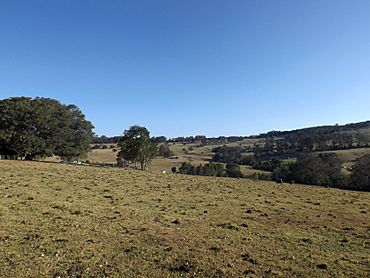Ravensbourne, Queensland facts for kids
Quick facts for kids RavensbourneQueensland |
|||||||||||||||
|---|---|---|---|---|---|---|---|---|---|---|---|---|---|---|---|

The rolling hills of Ravensbourne, 2014
|
|||||||||||||||
| Population | 307 (2021 census) | ||||||||||||||
| • Density | 3.748/km2 (9.71/sq mi) | ||||||||||||||
| Postcode(s) | 4352 | ||||||||||||||
| Area | 81.9 km2 (31.6 sq mi) | ||||||||||||||
| Time zone | AEST (UTC+10:00) | ||||||||||||||
| LGA(s) | Toowoomba Region | ||||||||||||||
| State electorate(s) | Condamine | ||||||||||||||
| Federal Division(s) | Maranoa | ||||||||||||||
|
|||||||||||||||
Ravensbourne is a small rural area located in the Toowoomba Region of Queensland, Australia. It's a quiet place with beautiful natural surroundings. In 2021, about 307 people lived here.
Contents
What is Ravensbourne Like?
Ravensbourne is found in the southern part of Queensland, in an area called the Darling Downs. This region is known for its rolling hills and farming land.
Rivers and Waterways
The Esk–Hampton Road runs through Ravensbourne, connecting different parts of the area. A large reservoir, or artificial lake, called Cressbrook Dam is located in the northern part of Ravensbourne. Most of the water in this area flows into Cressbrook Creek, which then joins the Brisbane River.
A small section in the southeast of Ravensbourne is part of the Lockyer Creek area. This is where you'll find the Ravensbourne National Park, a special place for nature. The western boundary of Ravensbourne is marked by Perseverance Creek.
A Look Back in Time
The name "Ravensbourne" comes from an old land division called a "parish." This parish was named after a man named Mr. Raven, who had a large farm (a "pastoral run") near a creek. In some parts of England, a creek is called a "bourne."
Early Settlements and Schools
In 1880, a camping area was set up here, but it was closed a few years later in 1885. In the late 1880s, a small village settlement began to grow. It had a post office and small plots of land for houses.
The Ravensbourne Provisional School opened its doors on June 22, 1891. It later became Ravensbourne State School in 1909. The school helped the community, serving as a meeting place for groups like the Farmers' Association. Over time, a general store and a sawmill also opened. The school closed on December 31, 1969, and the post office and general store are no longer open today.
Not many of the original village buildings are left. The land where the school once stood is now owned by the University of Southern Queensland and is a scientific reserve. In 2003, an old cottage from Ravensbourne, called Reushle Cottage, was moved to Hampton to become a visitor information center.
Farming and Timber
Evidence of Aboriginal people digging for yams (a type of vegetable) can still be found in Ravensbourne National Park.
Logging, which is cutting down trees for timber, started in the 1860s and 1870s. By 1891, two sawmills were operating in the area. One was near Perseverance Creek, and another was closer to the Ravensbourne village.
In 1889, when the Ravensbourne area was opened for new settlers, large parts of the land were cleared. Farmers grew crops like maize (corn) and potatoes, and also raised dairy cows. Today, the rich soil is still used for farming, including cattle, avocados, limes, and other vegetables and meat products.
Mining for Minerals
People also looked for gold in Ravensbourne, especially at a place called Bunkers Hill, starting in the 1870s. By 1932, about 25 men were working there. In 1933, gold, silver, copper, and lead were found about 7 meters underground. However, gold mining in this region was never as big as farming and raising animals.
Ravensbourne also has an open-cut mine for Kaolin, which is a type of clay used in many products.
How Goods Were Moved
In the early days, farmers used carts to take their goods from Ravensbourne to Hampton. From Hampton, the goods would go by train to Toowoomba to be sold. In the 1920s, trucks started to replace carts, taking goods directly to Hampton or Toowoomba. After 1932, the Esk–Hampton Road became easier to use, allowing access to the Brisbane Valley railway line.
A private railway line, called the Munro Tramway, was built between 1907 and 1909. It reached Ravensbourne and ended at Bunkers Hill. This tramway was used until 1936 to move timber and other goods between loading stations, sawmills, and the main railway connection at Hampton. Not much of the tramway is left today because most of its steel was taken away after it stopped operating. However, a partially restored old train engine, called a Shay locomotive, that was found at Bunkers Hill, is now on display near the Ravensbourne National Park.
Population
In 2016, Ravensbourne had a population of 248 people. By 2021, the population had grown slightly to 307 people.
Fun Things to Do
If you visit Ravensbourne, you can enjoy several short walks along the path of the old Munro Tramway. You can also see a partially restored Shay locomotive (an old train engine) from the Esk–Hampton Road near Ravensbourne National Park.
Ravensbourne National Park is a great place for picnics and short walks. You can also visit the Gus Beutel Lookout for nice views.
For camping, seeing kangaroos, and water activities, you can go to Cressbrook Dam and Perseverance Dam.



